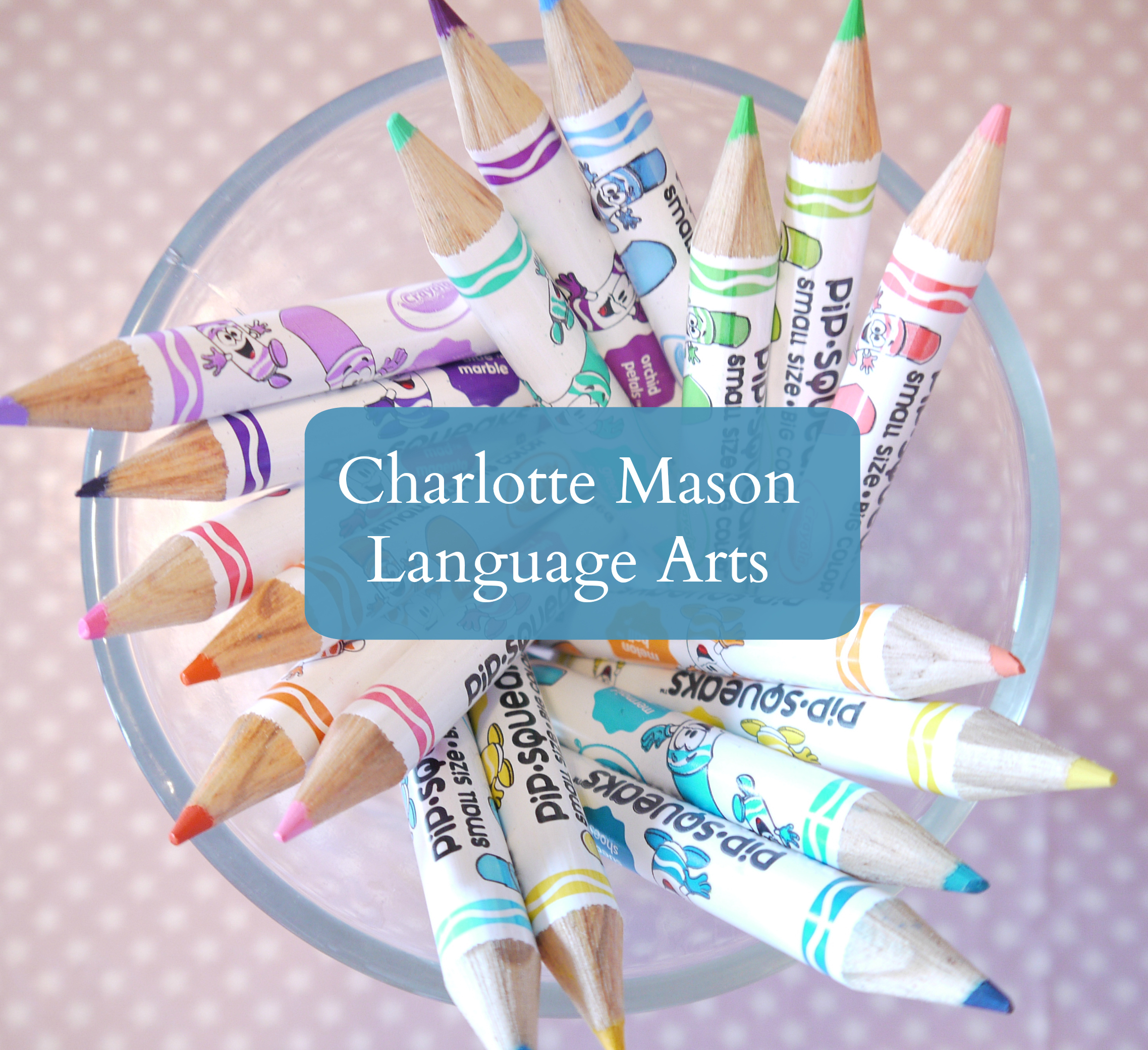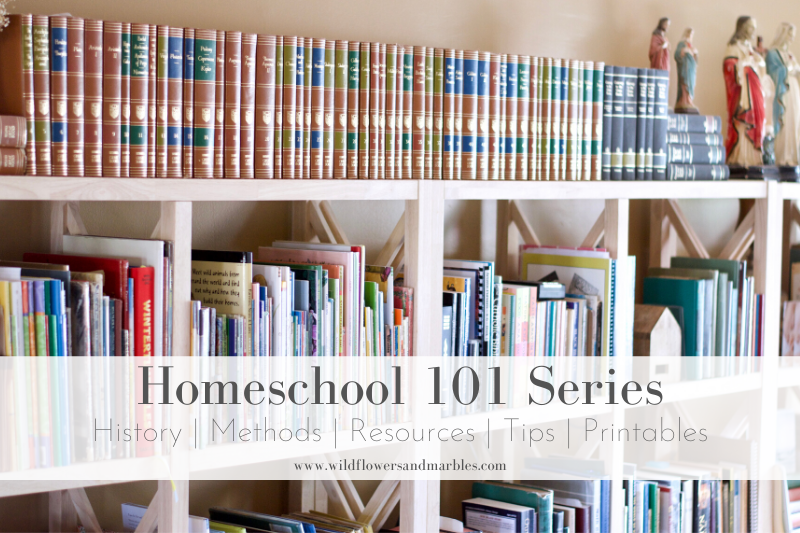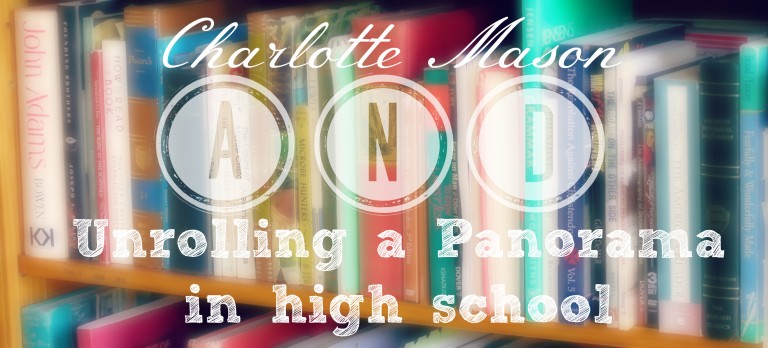Considering Language Arts – A Day in the Life
 This is the final post in a series considering Language Arts.If you’re still reading at this point, you probably have one burning question, “How in the world does it all fit?” All the generous feasting on living books, the liberal education, the narration, copywork, dictation, grammar, composition? It’s one thing to break it down and discuss practicals, but it does help to see how it might look. I’ll share. In the blue navigation bar above, I share a variety of “paper stuff” things that I’ve built over the years – in the hope that in seeing how one mom schedules her days, you can gather ideas for your own days.
This is the final post in a series considering Language Arts.If you’re still reading at this point, you probably have one burning question, “How in the world does it all fit?” All the generous feasting on living books, the liberal education, the narration, copywork, dictation, grammar, composition? It’s one thing to break it down and discuss practicals, but it does help to see how it might look. I’ll share. In the blue navigation bar above, I share a variety of “paper stuff” things that I’ve built over the years – in the hope that in seeing how one mom schedules her days, you can gather ideas for your own days.Our plans are living; which is to say, I wrote these, lived them, adjusted and we lived them more. These lesson plans act as an extraordinary guide, not a straight-jacket. I print our weekly plans every Friday and attach a particular child’s plans to their individual clipboard. We make notes and record progress on the plans throughout the week. At the end of the week, they are filed, and a new set of sheets replaces them. This has streamlined my lesson planning and over the years, this is the format I’ve settled into with my crew. I ask you to remember that these plans are built for my children, based on their needs, interests, and abilities, and in no way is my sharing meant to prompt unhealthy comparison or inner turmoil about your choices. Ok? Just imagine we’re all sitting around chatting in my living room, and I show you my plans. You look them over considering them in light of your family; you might grab a few ideas and leave the rest….or leave the whole thing if you think I’ve lost my mind! I just ask you to understand my motivation for sharing – this is to prompt your own inner brainstorming and give you something to visualize so that you can take ideas and tools to fit your day and your family! 🙂 Questions are certainly welcome! I believe strongly that we {home educating moms and the children they home educate} need plans that foster independence and the self-education Charlotte Mason spoke of:
“(Children’s) education should be largely self-education. A sort of correspondence school was set up, the motto of which,––”I am, I can, I ought, I will,” has had much effect in throwing children upon the possibilities, capabilities, duties and determining power belonging to them as person.” Volume 6, p. 28 -29
These plans we’re living work well toward that end. We’re enjoying our days. The children are reading, learning, and loving their learning. They know what they “ought” to be doing. It’s a treasured time. Because our days reflect Charlotte Mason’s methods and philosophies, you will find this expressed in our plans. Specifically, you will find language arts represented on these plans:
- Narration is noted on the lesson plans under specific books for which the children will offer a narration. My 5th graders and younger offer oral narrations only. 5th grade + begin written narrations. We begin slowly; one a week, and progress from there each year.
- Keep in mind that Charlotte Mason didn’t indicate which books would be narrated in her plans; students needed to be prepared to narrate anything they read. Charlotte wasn’t juggling a variety of children all at once: one of whom is learning to read, another of whom is a toddler in need of almost constant attention to foster good habit formation…the house…the laundry…the day. I am.
- Indicating clear expectations of a narration on my plans has been a tool for me serving as a visual reminder and keeping me accountable to the valued practice of narration! I may ask for narrations that aren’t indicated on the lesson plans!
- Narrations satisfy both oral and written language arts, so writing practice is covered under this heading as well – 2 birds with one stone. I like it when methods are super efficient!
- Narrations happen daily for both children, multiple times a day.
- Copywork is indicated for all students 7th grade and below. Once a student has mastered the skill of letter formation and good penmanship, I do not include separate copy work lessons on those plans.
- Dictation and Grammar exercises are both integrated with Dictation lessons. Grammar lessons are gently integrated in short lessons throughout the week alongside dictation lessons, as well as offered after written narrations. You might occasionally find a mention of grammar during copywork.
- General language arts curriculum – It isn’t necessary to use this in addition to the other language arts I’ve offered. I will mention (below) a few very good Charlotte Mason resources that I recommend if you need a little hand holding. There are also some other really great general language arts helps/curriculum, in the resource review section of the very first post in this series.
- When incorporating Charlotte Mason’s method’s with additional language arts curriculum, I have to be attentive and watchful – it’s a fine line between challenging and overwhelming.
- I stagger Copywork and Dictation days. Fridays are writing days, and I enjoy making use of Free Writes – 10 minutes of pen to paper.
The day…
- For a young child/new narrator, I read very little before I ask for a narration. I am probably still reading aloud a lot to this child at this point (around 6 years old). For a brand new narrator, I read a paragraph and then ask for a narration. As they become more proficient…two paragraphs, then a page. By 4th grade, my students have all practiced enough at narrating, and their reading skill has improved to a competent independent reader, that they can read 2 – 3 pages and then narrate.
- If I have to pick out a student’s copy work selection every day, I’ll pull my hair out! Investing a couple of hours choosing and printing a student’s copy work for the term is a SOUND investment of time at the beginning of each term! I bind copy work books with my Proclick.
I do my best to stagger my day so that in the morning, I’m listening to group narrations with all my students as part of our Morning Basket of work, after that I read to and listen to elementary age narrations, lunchtime prep allows me to hear a couple of narrations from my Middle School or High School students, then I tackle dictation lessons in the afternoon.
There you have it! Language Arts! I sure hope this has been helpful!!! Now…
Because you asked…
I compiled the entire language arts series, including this post into one document for you. I hope it’s a help. I know I can only handle a finite amount of blog reading! All the links are hot. You know…I had no idea that I had gone on quite that much. LOL!
Click here to print a free ebook condensation of all posts in this series –> Considered Language Arts
Consider your days. Free your shelves and your days of cumbersome handwriting workbooks, spelling workbooks, grammar workbooks, and dry reading comprehension questions! Fill your shelves and your days with beautiful living books and allow your lessons to connect. Foster relationships between your children and rich, noble ideas within the covers of these living books! Leave enough margin in your day so that your children can enjoy their reading and have time to explore! Let the learning moments in your home be a feast of generous thoughts and literary richness!







You are the best ~ this is wonderful!
Please say that you plan to do this with all subjects! I thouroughly enjoyed this series! I am not presently homeschooling my children but am making a plan to start in the future. I am really focusing on CM! Thanks!!
Thank you so much, ladies! Deo Gratias if this was helpful!
Maybe you've already included this, but I am wondering what book/curriculum you use to teach composition to your 9th grader. I've tried winging it with grammar and composition handbooks,but am not satisfied. At the same time, I'm reluctant to spend a lot of money on a labor intensive writing course, because I don't think we would want to spend the time required. Thanks so much for all you're helpful information.
Hi Bria. Thanks for your question. I review the resources we're using for 9th grade composition on the post before this one on writing and composition:
http://wildflowersandmarbles.blogspot.com/2010/07/considering-language-arts-composition.html
Hope that helps!
These posts are all so wonderful! Off topic question…what book do you use for the Architecture made easy art lessons? This sounds really interesting. Thanks for your inspiration.
Hi Kelly! We LOVE those Architecture Made Easy Art Lessons!!! An art teacher shares them at her website:
http://www.deepspacesparkle.blogspot.com/
If you check out her right sidebar you'll see the pdf's she offers – Architecture Made Easy is here:
http://deepspacesparkle.blogspot.com/2009/08/deep-space-sparkle-presentsarchitecture.html
Have fun clicking around on that AMAZING site! All of our art this year comes from her wonderful lessons!
Jen,
Thanks so much for doing this series, it was both inspiring and encouraging to return to the CM basics. I pray blessing upon blessing for you and your family this season. I have been reading your blog for about a year and your posts always leave me thoughtfully smiling–thanks.
Tammy,
I know exactly what you mean! I was inspired and encouraged to get back to our CM anchors as well! It's been completely refreshing for me!
So glad you enjoy the blog and the series! Thank you so much for your kind words and prayers!!! God bless you as you plan for a lovely new school year!
Your writing is always a treasure from the Lord to me. This has been soooo helpful and inspiring.
This is very interesting and gives great detail on what each grade offers!
I've (ahem) finally sat down and read your whole language arts series and it is wonderful. Thank you so much for sharing your thoughts and plans. You've given me a lot to ponder and consider. Thanks again and God bless.
I still don’t understand how you have time to plan everything and fit it all in. Did you have a mentor at some point? I have just started looking through your site and I am so overwhelmed. I love your style but it seems so unrealistic for someone like me. I have one child who is 1 and I am just started to think about homeschooling but I have to admit I am leaning towards Seton as it seems easier on me. Do you have any experience with Seton? Obviously I know you don’t use it but how do you do this all? You are amazing.
Hi Heidi,
Thanks for the comment! First, let me say that if you feel overwhelmed here, then maybe this isn’t the place for you. I would only ever want this to be a place of refreshment: ideas here are free for the taking! Second, I need to be clear: I am no supermom. I’m as real as it gets! The house can be messy, lessons can sometimes be incomplete, and my children are not perfect. I am also a hard worker; I see challenges and look for creative answers rather than purchasing something to *fix* it; I like being creative; and I have been at this for 12 years – so experience is a big help! So, thanks for letting me get that straight!
What is assembled here on this blog is the sharing of 12 years of hard work. I share it all because I’m in the trenches with {at the time of this comment} an infant, a 6 year old, 9 year old, 13 year old, and a 17 year old that is about to graduate and I really delight in sharing with other home educating moms…also in the trenches. I write from that perspective – it’s a panorama of sorts, and it’s not meant to be overwhelming. It is shared in the hopes that it might inspire others to dig in, be creative, brainstorm, work within your means, your talents, within the unique circumstances God has given you. I embrace that and I live it. And that belief undergirds why I do what I do, how I do it, and why I share…especially why I share here.
If the style I share is unrealistic to you {to anyone!}, or leaves you without a sense of peace – then I’m the very first to say – move on with great joy! This is NOT a one size fits all vocation we embrace! Thanks be to God there are many, many roads. {I have no direct experience with Seton, but I’ve seen their program and honestly find it dry, overwhelming and loaded with busy work. It doesn’t fit the educational philosophy I embrace of a living education! Others make it work for them – it fits their needs. You’ll just need to look critically at it and decide for yourself if it’s a fit.}
Now, if you’ll allow me a minute to offer this….you have one child that is 1, so of course everything here is overwhelming. You’re lens is on wide angle {you’re looking at things I share with my high schooler on down} – tighten up your focus a bit and just keep your eyes and your imagination open to ideas for the next 3 or so years. If you stick to posts that only address pre-school, an atmosphere at home that is open to learning, good habits, little people working alongside, eyes open to wonder – I think you’ll find those ideas a bit more do-able and less overwhelming to consider.
Good luck to you in finding a style that fits, Heidi!
Thank you for finding time to reply. That was so sweet. I think I am just getting ahead of myself and thankfully I still have time to figure some things out and accept that I will grow in the process. I do appreciate your site so much though. I agree with your advice that I just need to narrow my focus and not get carried away. I doubt I will go anywhere as I enjoy peeking on here 🙂
Hi Jen!!! I love the new blog! I have a question for you. Where do you keep all of the written narrations, copywork, or basically all of their written work? My daughters are in 7th and 5th grades, so I am not yet bound to record keeping. But, I do want to try to be more disciplined next year to prepare for high school. Any help you can offer would be great!!!!
Hi Kellye,
Excellent question!
** For written narrations, I have the kids email those to me. I create a special folder in my email inbox where I keep all of their written narrations and then after the year is over, I save them on my hard-drive. When a student is working on more formal written narrations, I have them complete those using a word processor program, and again, they email those to me so I can keep them all.
** For copywork and/or dictations, I use a simple lined journal notebook for all written work for the year. I keep both copywork and dictation in the same notebook. It’s just easier than having several notebooks floating around for us. Copywork is only kept up while they’re mastering their penmanship. Once the skill of print and cursive is in hand, I no longer require copywork. So, a child usually keeps a copywork notebook from 1st – 5th grade. We start dictation lessons around 4th or 5th grade. So, we keep a dictation notebook from 4th/5th – 11th/12th.
Hope that’s a help, Kellye!
Yes!!!!! Thank you so much!!!!!! The emailing is such a great idea that I have never thought of before! I’ve got a touch of “March Fever” over here and have started a bookmark folder of all the changes I want to implement next year!!! The emailing of the narrations is at the top of my list!!!! Thank you again!!!